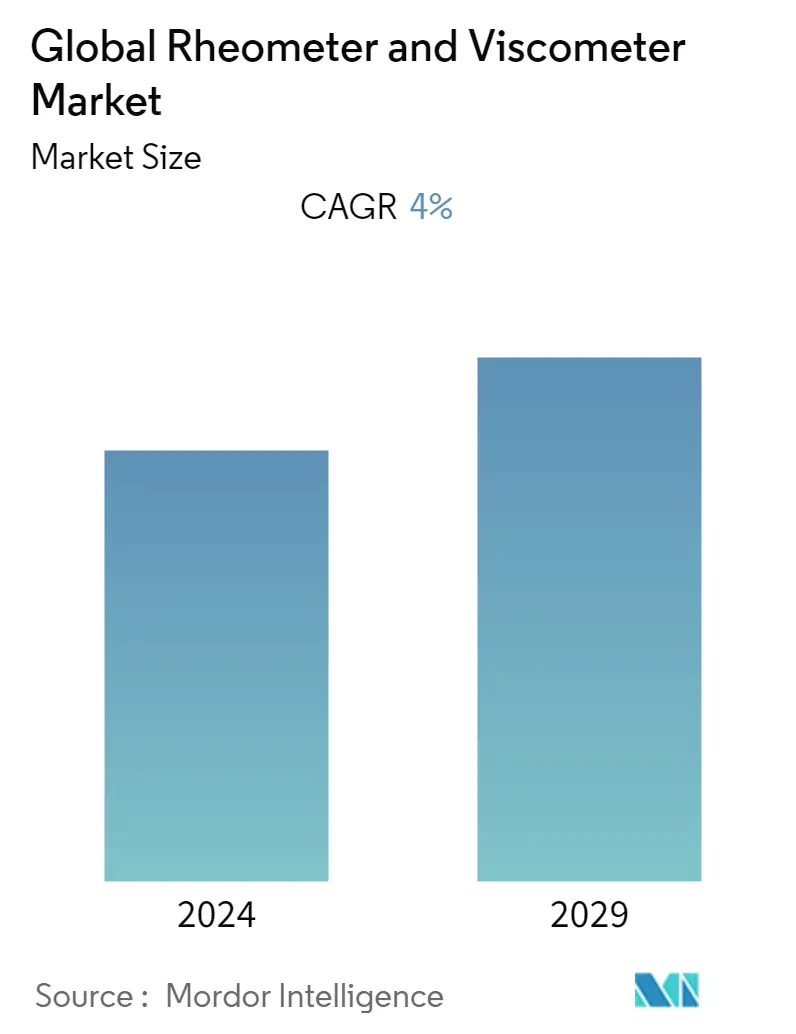Market Size of Global Rheometer and Viscometer Industry

| Study Period | 2019 - 2029 |
| Base Year For Estimation | 2023 |
| Forecast Data Period | 2024 - 2029 |
| CAGR | 4.00 % |
| Fastest Growing Market | Asia Pacific |
| Largest Market | North America |
Major Players
*Disclaimer: Major Players sorted in no particular order |
Rheometer and Viscometer Market Analysis
The rheometer and viscometer market is expected to register a CAGR of 4% over the forecast period.
COVID-19 has influenced every element of society and it has impacted the healthcare and medical device industry, and so has affected the rheometer and viscometer devices market on a global scale. The government regulations and lockdown led to a substantial decline in overall non-emergency treatments, which in turn decreased the usage of viscometers and rheometers. Although cardiology departments offered emergency and outpatient treatments, the number of patient visits to hospitals declined dramatically in the initial month of COVID-19. An article titled, "The role of plasma viscosity testing in managing COVID-19 disease" published in May 2021 reported that plasma viscosity significantly got increased in COVID-19 patients and thus, viscosity become an important, inexpensive and accurate test to identify the individual is SARS-CoV-2 positive or not. Thus, sales of rheometer and viscometer devices dropped initially, but after a few months, the market witnessed significant growth.
The factors that are supposed to be driving this market are the expansion of petrochemical and material manufacturing industries, technological advancements in rheometers and viscometers, and the rising global burden of target diseases. Viscometers have important applications in real-time quality and process control for a wide range of industrial processes, e.g. in the food, chemical, pharmaceutical, and petrochemical industries. For instance, an article titled, "Using texture analyzer to characterize pecan and olive oil tactile properties, compare to viscometer analysis, and link to fatty acid profile and total polyphenols" published in February 2022, reported that viscometer is an important quality control instrument used in checking the viscosity of different food consumable oil, and thus an important factor to check the fatty acid profile of oils.
The rising global burden of target diseases is also driving this market. The engineering of blood viscometers for the diagnosis, prognosis, and prevention of cardiovascular and other diseases has been the subject of significant research interest. These micro-blood viscometers are advantageous because they use very small sample volumes for quick, routine clinical purposes. For instance, in May 2021 an article titled, "Microfluidic viscometers for biochemical and biomedical applications: A review' reported that diabetes can be monitored by comparing the deviation in the viscosity of the blood serum with the normal person and it was concluded that the change in the viscosity was not dependent on age, obesity, gender, or any other disease. The viscosity of the blood is an important parameter; measuring it has a wide scope in disease diagnostics. The increasing burden of global diseases is also fueling the growth of the market.
Also, the new product launches are constantly propelling the growth of the studied market. For instance, in December 2021, the PCE instrument launched a new Krebs-Stormer viscometer with a touchscreen, the PCE-REVI-8. The new viscosity meter allows quick testing of samples not only at the laboratory but also directly in production or storage rooms under suitable environmental conditions. It is new is a practical device for convenient measurements.
Thus, due to the above-mentioned factors, the market is expected to show significant growth over the forecast period. However, the high cost of the viscometer and rheometer may slow down its growth.
Rheometer and Viscometer Industry Segmentation
As per the scope of the report, a rheometer is a type of laboratory instrument, which can also work as a viscometer. A rheometer is used to measure how liquid suspension flows in response to an applied force, whereas a viscometer is an instrument used to measure the viscosity of fluid and flow properties of liquids under one condition. The Rheometer And Viscometer Market is segmented by Product Type (Rheometers (Dynamic Rotational Rheometers, Torque Rotational Rheometers, Capillary Rheometers, and Other Rheometers), Viscometers (Rotational Viscometers, Process Viscometers, Capillary Viscometers, and Other Viscometers)), End-Users (Pharmaceutical, Cosmetics, and Biotechnology Companies, Food and Beverage Manufacturers, and Other End-Users) and Geography (North America, Europe, Asia-Pacific, Middle East and Africa, and South America). The market report also covers the estimated market sizes and trends for 17 countries across major regions globally. The report offers the value (in USD million) for the above segments.
| By Product Type | ||||||
| ||||||
|
| By End-Users | |
| Pharmaceutical, Cosmetics, and Biotechnology Companies | |
| Food and Beverage Manufacturers | |
| Other End-Users |
| Geography | ||||||||
| ||||||||
| ||||||||
| ||||||||
| ||||||||
|
Global Rheometer and Viscometer Market Size Summary
The rheometer and viscometer market is poised for steady growth, driven by advancements in technology and increasing applications across various industries. These instruments play a crucial role in quality control and process optimization, particularly in sectors such as petrochemicals, pharmaceuticals, and food processing. The market experienced an initial decline due to the COVID-19 pandemic, which disrupted non-emergency medical treatments and reduced hospital visits. However, the demand rebounded as the importance of viscosity measurement in diagnosing and managing diseases like COVID-19 became evident. The rising global burden of diseases, coupled with the need for precise diagnostic tools, has further fueled the market's expansion. New product launches, such as advanced viscometers and rheometers with enhanced features, are also contributing to market growth.
Regionally, North America is expected to maintain a significant share of the rheometer and viscometer market, supported by technological advancements and a robust healthcare infrastructure. The increasing incidence of foodborne illnesses has heightened the demand for food safety and quality checks, driving market growth in the region. The presence of major industry players and ongoing innovations, such as high-performance rheometers, are key factors supporting this trend. The market remains fragmented, with several international and local companies competing for market share. Despite the high cost of these instruments potentially hindering growth, the overall outlook for the rheometer and viscometer market remains positive, with significant growth anticipated over the forecast period.
Global Rheometer and Viscometer Market Size - Table of Contents
-
1. MARKET DYNAMICS
-
1.1 Market Overview
-
1.2 Market Drivers
-
1.2.1 Expansion of Petrochemical and Material Manufacturing Industries
-
1.2.2 Technological Advancements in Rheometers and Viscometers
-
1.2.3 Rising Global Burden of Target Diseases
-
-
1.3 Market Restraints
-
1.3.1 High Cost of Viscometer and Rheometer
-
-
1.4 Porter's Five Force Analysis
-
1.4.1 Threat of New Entrants
-
1.4.2 Bargaining Power of Buyers/Consumers
-
1.4.3 Bargaining Power of Suppliers
-
1.4.4 Threat of Substitute Products
-
1.4.5 Intensity of Competitive Rivalry
-
-
-
2. MARKET SEGMENTATION (Market Size by Value - USD million)
-
2.1 By Product Type
-
2.1.1 Rheometers
-
2.1.1.1 Dynamic Rotational Rheometers
-
2.1.1.2 Torque Rotational Rheometers
-
2.1.1.3 Capillary Rheometers
-
2.1.1.4 Other Rheometers
-
-
2.1.2 Viscometers
-
2.1.2.1 Rotational Viscometers
-
2.1.2.2 Process Viscometers
-
2.1.2.3 Capillary Viscometers
-
2.1.2.4 Other Viscometers
-
-
-
2.2 By End-Users
-
2.2.1 Pharmaceutical, Cosmetics, and Biotechnology Companies
-
2.2.2 Food and Beverage Manufacturers
-
2.2.3 Other End-Users
-
-
2.3 Geography
-
2.3.1 North America
-
2.3.1.1 United States
-
2.3.1.2 Canada
-
2.3.1.3 Mexico
-
-
2.3.2 Europe
-
2.3.2.1 Germany
-
2.3.2.2 United Kingdom
-
2.3.2.3 France
-
2.3.2.4 Italy
-
2.3.2.5 Spain
-
2.3.2.6 Rest of Europe
-
-
2.3.3 Asia-Pacific
-
2.3.3.1 China
-
2.3.3.2 Japan
-
2.3.3.3 India
-
2.3.3.4 Australia
-
2.3.3.5 South Korea
-
2.3.3.6 Rest of Asia-Pacific
-
-
2.3.4 Middle East and Africa
-
2.3.4.1 GCC
-
2.3.4.2 South Africa
-
2.3.4.3 Rest of Middle East and Africa
-
-
2.3.5 South America
-
2.3.5.1 Brazil
-
2.3.5.2 Argentina
-
2.3.5.3 Rest of South America
-
-
-
Global Rheometer and Viscometer Market Size FAQs
What is the current Global Rheometer and Viscometer Market size?
The Global Rheometer and Viscometer Market is projected to register a CAGR of 4% during the forecast period (2024-2029)
Who are the key players in Global Rheometer and Viscometer Market?
Anton Paar GmbH, Thermo Fisher Inc., U-CAN Dynatex Inc., Hydramotion and Shimadzu Corporation are the major companies operating in the Global Rheometer and Viscometer Market.

